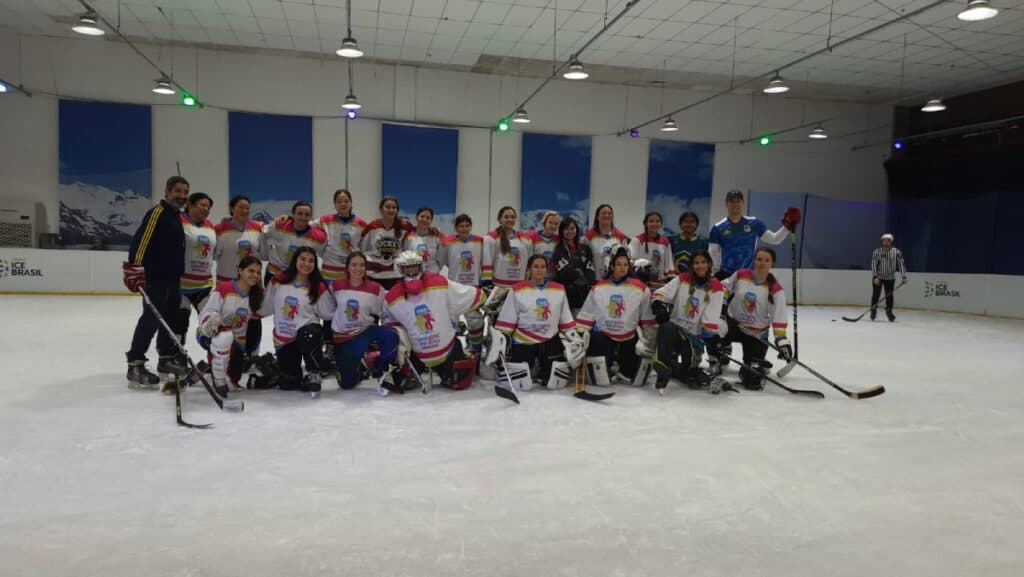Breaking the ice: How a young woman’s childhood dream is pushing hockey in Brazil closer to reality

This article was written by Maria Fernanda Pavanello, who is part of the Professional Hockey Writers Association x To Hockey With Love Mentorship Program. This program pairs aspiring writers with established members of the association across North America to create opportunities for marginalized people that do not traditionally get published on larger platforms covering hockey.
To Hockey With Love is a weekly newsletter covering a range of topics in hockey – from the scandals of the week to providing a critical analysis of the sport.
_____
Before Ana Boghossian moved to the United States in 2014, she would tell anybody who would listen that she wanted to come back after finishing her college degree to help develop hockey in Brazil. At 17, she was certain she was going to build the future of the game she loved to play in the country where she grew up.
As years passed, that dream became more and more distant from her reality. She had graduated and was putting down roots in Boston as a young marketing coordinator for a digital printing and graphics company. Hockey had become no more than a twice-a-week evening pastime in a beer league.
But life sometimes has ways of changing one’s path completely and, for Boghossian, it brought her back exactly to where she had once dreamed to be.
When COVID made its presence felt in the world, the company that handled mainly large-scale events and building and stage wraps took a big hit. Just like that, the office where Boghossian worked was closed, and despite all the years she had spent abroad, she found herself going back to Brazil.
It was a sudden change. At the time, Boghossian remembers having no idea what to do next. “When I got back, companies definitely weren’t hiring and then I thought about developing my portfolio here. I began making some hockey things during my free time, and I didn’t ask anyone about it, I would just go and present [what I had made].”
During those conversations with people in clubs and federations, Boghossian elaborated on her vision for growing ice hockey in Brazil in a sustainable way. She came up with a long-term development plan and initiatives that focused on bringing more women and children to the game.
Her efforts certainly didn’t go unnoticed and one day she was contacted by the Director of Hockey for the Brazilian Ice Sports Federation (CBDG), Salvador Neto, who offered her a position within the organization to help develop the sport and take hockey in Brazil to the next level. “One thing led to the other. My need to create a professional portfolio associated with a pre-existing motivation of a lifetime brought me here, to a position to fight for hockey, especially women’s hockey in Brazil, like I always wanted to be.”
Due to a lack of ice sports facilities in a predominantly tropical country, most hockey players in Brazil are first introduced to the game on inline skates. That wasn’t the case for Boghossian. She grew up in the West Zone of Rio de Janeiro just 10 minutes away from a small ice rink built in a shopping mall in Barra da Tijuca. She had an uncle that bought her first pair of skates when she was 6. “He taught me all the fundamentals of skating,” she remembers. “Then at 9 years old, I started playing [hockey] at the mall rink because my brother and his friends were taking lessons there.”
As Boghossian took her first strides on the ice, hockey in Brazil was moving forward in inline competition. The country had been a member of IIHF since 1984 (the organization also governed inline hockey until 2019), and during the late 1990s and early 2000s, the sport peaked in popularity with well-known soccer clubs such as Flamengo, São Paulo, and Palmeiras supporting their own inline hockey teams, as well as national championships being broadcast on network television.
Between 2003 and 2009, Brazil’s men’s national team found its greatest success competing at the Division 1 of IIHF’s Inline Hockey World Championship, as they collected six medals over seven years, winning gold in 2007.
“With all the support from clubs that [had a lot of prestige] in soccer, at a time where rollerblades were a trend,” Boghossian says it was a golden age for men’s hockey in Brazil. However, there didn’t seem to be a good opportunity for the game on ice.
“There was [an ice rink] at Barra Shopping,” Boghossian recalls, “but it was small, you couldn’t really play [hockey there]. It was also the time when a man named Geraldo Cardoso came up, who was pivotal in the rise of ice hockey in Brazil.”
Cardoso, former player and coach, led the ice hockey initiatives in Rio, following the mall rink to a couple of new locations over the years, and it was one of the only places – and for some periods, the only one – in Brazil where at least a version of the game could be played on ice.
“That was the foundation of everything we did on the ice for a long time. I mean, the basis of something to be built, and that brought the first ice hockey tournaments in the country. Even the first with prize money.” Boghossian recalls. That tournament was the Rio-Sao Paulo Challenge (Desafio Rio-São Paulo), which invited some of Brazil’s inline hockey stars from those two states to try to play on the ice.
Boghossian’s memories of that tournament are bittersweet. “I was 16 and it was the first competition I wasn’t allowed to play because [I was a woman].” Cardoso told her it wasn’t going to happen, she was too small to play with the other guys. “I gulped, went home, cried the whole day; I had never been denied anything for being a woman.” The frustration was such that, with some help, Boghossian was able to organize a women’s tournament concurrently and bring other inline players to try out the ice for the first time.
At this event Boghossian met Sonia Casanova and her twin daughters, Anita and Renata, for the first time. Sonia Casanova, or “Tia Sonia” as Boghossian fondly refers to her, is widely known in the hockey community in Brazil and Latin America and has had a great influence on how the sport developed in the country in more recent years. Her daughters began playing inline hockey at a young age and, through them, she also started to take an interest in the game.
“The Casanova family is an iconic unit for hockey in Brazil. Without them, a lot of things simply wouldn’t have happened [for both the men’s and women’s game] here. ‘Tia Sonia’ is a very communicative person, [she created] good relationships with hockey leadership in Latin America, and abroad in general. Especially with the president of the Mexican federation.” Having lived in Mexico before, Casanova was a key piece in bringing the first women’s team to compete for Brazil at the Pan-American Ice Hockey Tournament in Mexico City in 2017.
“We had been there before, in 2015, with a team that was completed in great part by Mexican players, also thanks to her [efforts],” Boghossian explains.
Between 2014 and 2017 the IIHF’s Latin American members organized a Pan-American tournament which provided a platform for countries that lacked proper facilities and didn’t participate in the IIHF Ice Hockey World Championships program to compete on the ice.
Since 2018, there have been more opportunities for developing hockey nations to participate in international competition with the beginning of the Development Cup by the IIHF as well as the creation of Amerigol, an association that, with the support of the NHL, organizes international ice hockey events in the U.S. like the LATAM Cup, in Florida, and the Spring Classic, in Texas.
Boghossian knows that such tournaments are important to offer players a chance to play more and improve their skills on the ice. She also believes these events represent an opportunity for countries looking to grow the sport to learn what other federations are doing, and exchange experiences and best practices that could be applied or adapted in their own programs. “Why does the Philippines have [a full-size ice rink] and [Brazil] doesn’t? What conditions are so different in South Africa that we couldn’t possibly replicate in Rio Grande do Sul, for instance? There are places cold enough [in Brazil] to maintain a rink without super high energy costs, even in Sao Paulo,” she argues.
In 2020, the most populous city in the Americas became home to Brazil’s first permanent dedicated ice sports facility with the launch of Arena Ice Brasil by CBDG. The rink, which is only large enough for 3-on-3 hockey, opened shortly before COVID hit and it was months before the Federation could resume normal operations and put solid initiatives in place for each sport they were looking to promote there. It was during that period of uncertainty and major interruptions due to the pandemic that Boghossian joined CBDG and began to put her plans into action. Now, she has a lot to show for the past year’s work. One weekend in particular in late November encompassed many “firsts” for” for Brazilian hockey and especially the women’s game.
From November 25th to the 27th, Arena Ice Brasil hosted the country’s first World Girls’ Ice Hockey Weekend, a yearly worldwide event conceived by the IIHF to help its members promote hockey and encourage girls to try out a new sport.

During those three days, several activities for different age groups and skill sets took place on and off the ice of the facility. Over 25 girls and women had the chance to get more familiar with the game and even compete in the country’s first official Women’s 3-on-3 Ice Hockey Championship – following the Men’s Championship which had been played at Arena Ice Brasil just the weekend before.
The medal ceremony served as a closing point for the whole event. It was the right place to honor the Casanova family, who coincidentally was part of the championship’s winning team, with the creation of the Sonia Casanova Award in recognition of the achievements in favor of strengthening women’s hockey in Brazil. Women’s National Team players Nina Yamamoto and Izabel Nori were the first recipients of the award for their Instagram account @MulheresDoHockey (Women of Hockey), a page created in March to promote women’s teams all over the country and provide a platform for athletes and fans to engage and connect with the rest of the hockey community.
It was an emotional moment of realization for Boghossian and many participants as to how far the sport had come and all there is to look forward to. She believes this inaugural WGIHW was important to keep players motivated and help bring more people to hockey in the future. “I think the key [for next year] to be even more successful is to attract girls that didn’t participate this year and have them practice and play on ice so that we can have something even greater [in 2023].”
Without spoiling CBDG’s plans for hockey in 2023 just yet, for the first time, Boghossian can confidently say there will be many opportunities for men and women to practice and compete on ice, both locally and abroad. After all, she’s making it happen.
_____